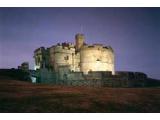Pendennis Castle - Falmouth
| |||||||||||||||||||||||
Constructed between 1540 and 1545, Pendennis and its sister St Mawes Castle form the Cornish end of the chain of coastal castles built by Henry VIII to counter a threat from France and Spain. Thereafter Pendennis was frequently adapted to face new enemies over 400 years, right through until World War II. In 1598, during Elizabeth I’s reign, a new type of defensive rampart was added around the original fort. The castle was strengthened again prior to the Civil War and played host to the future Charles II in 1646, before he sailed to the Isles of Scilly. It then withstood five months of siege, before becoming the penultimate Royalist garrison on the British mainland to surrender. Pendennis continued to play a vital role in Cornwall’s defences throughout the late 19th and early 20th centuries, and saw significant action during World War II. Evidence of its fascinating history is on show throughout the site. The Noonday Gun is fired every day during July and August, and the Guardhouse has been returned to its World War I appearance. You can also visit the underground magazines, including the World War II Half Moon Battery (by guided tour only), as well as the original 16th-century keep with its recreated Tudor gun deck. The refurbished 1901 Royal Artillery Barracks houses an interactive exhibition, tracing the history of the castle, its people, and its links with Falmouth and the trade routes of the British Empire. A key feature is a handson scale model of the castle: with the aid of special effects, children will also now be able to step into the shoes of a soldier on kit parade. The education suite, with two large child-friendly education rooms and a wet room for creative workshops, can accommodate up to 120 children. The hospitality area is not only a fully-equipped conference centre but also an exceptional wedding venue, with the Fal Estuary as a stunning backdrop. | |||||||||||||||||||||||
